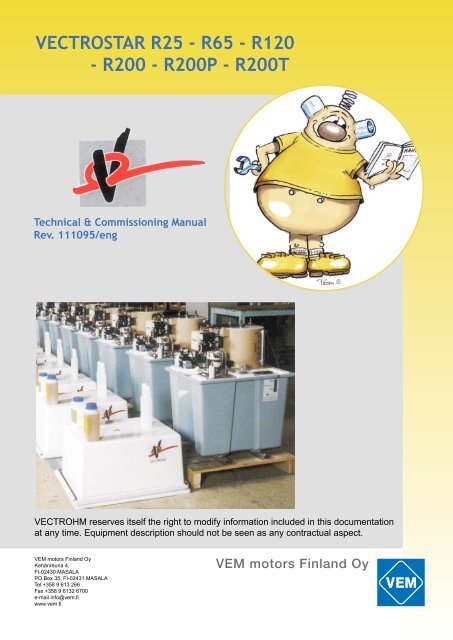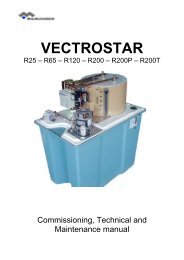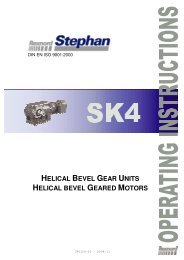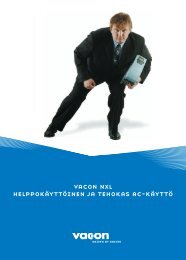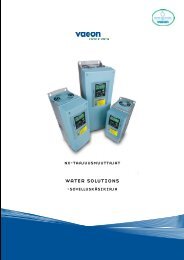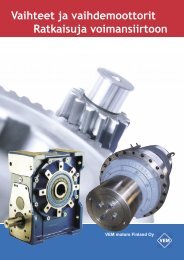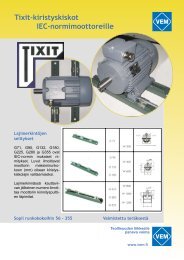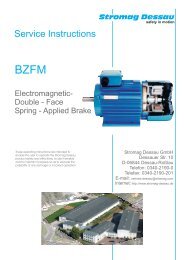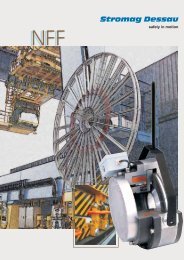vectrostar r25 - r65 - r120 - VEM motors Finland Oy
vectrostar r25 - r65 - r120 - VEM motors Finland Oy
vectrostar r25 - r65 - r120 - VEM motors Finland Oy
- No tags were found...
You also want an ePaper? Increase the reach of your titles
YUMPU automatically turns print PDFs into web optimized ePapers that Google loves.
A – NOMENCLATURE – USE OF EACH PARTABCEFGHIJKLMNOFixation RailsElectrolyte Reserve TankPump SetFill-up HoleStart-up TankRecycling ValveFlow ValveTimer RelayControl Circuit TerminalsElectrodeElectrodes Terminals (to the motor)Electrodes Holding PlateBars SetShort-circuiting Contactor
B – RUNNING PRINCIPLESI) IntroductionThe starters VECTROSTAR R are designed to reduce a specific startingresistance as gradually as possible and as harmoniously as possible according tothe resistant torque of the machine, ending at a value close to 0, at the end of thestarting sequence.For such a matter, 3 conical electrodes (the top down) are connected to the 3 rotorrings of the motor.Those electrodes are fitting in the starting tank which contains some electrolyte. Thebottom of each electrode bathes in the liquid (made of water mixed with a smallpercentage of conducting soda). The resistance so induced is the Initial StartingResistance (R 0 )NB : The value of this initial resistance can be adjusted with the soda dosesat the commissioning.When the line contactor is energized, and only at this very moment, the motortorque is T so . It is called the Initial Starting Torque.II) Filling of the starting tankWhen the stator line contactor is switched on, the pump motor is powered on. Theelectrolyte coming out from the reserve tank is propelled into the starting tank. Thelevel is rising progressively in the starting tank.The resistance is varying continuously, very smoothly and without any interruption.All the transformed torque curves of the motor are used, offering thus a continuousoptimisation of the torque. The automatic adaptability of the principle is totally used,the resistance is fully adapted at any time.
II)Commissioninga) Introduction* Important note:To be definitive, the dosing must be done onsite, in the most difficultstarting conditions. Even if the starting is exceptionally done loaded, itis necessary to have these conditions for the adjustment.b) Measuring instrumentRemark: The rotor voltage of a ring motor is equal to U r (rotor locked). This valueis indicated on the motor plate.As the motor is speeding up, U r decreases, aiming at a low voltage at the end ofstarting (lower than 6% of U r written on the plate).The best way to follow the speed variations of the motor is to measure thevariations of the rotor voltage.Connect a voltmeter between two of the three starter bars.‣ The voltmeter calibre must be compatible with the maximum alternativevoltage U r (see motor plate).c) Preparation of the electrolyteATTENTION :‣ Do not pour the electrolyte into the starter right after the preparation.‣ Electrolyte is a dangerous chemical.⇒ Handle with care.⇒ Put on gloves. In case of contact with the skin or the eyes, rinseabundantly and take medical advice.In a water bucket, pour soda gradually according to the following table:R25 R65 R120 R200Quantity of water (l) ½ 1 1 2Quantity of electrolyte (g) 250 500 500 1000It should be observed that during the dilution, an exothermic reaction occurs. Themixture temperature can rise up to 90°C.Let it cool down.Once the mixture has cooled down, pour it into the dosing bottle according to the followingfigure.
d) Time relayDuring the tests, adjust short-circuiting time relay to the higher value in order to avoidany undesirable short-circuiting.e) DosingFirst, test the starter with water only (without soda) and measure the variations of therotor voltage.‣ If the rotor voltage gets stabilized or does not decrease, stop the startingsequence within 5 seconds.Note the voltage value as:test without soda: Ur water =….Make sure that motor works properly. (ie: the motor is stopped, or runs then getsjammed or runs without speeding up)Switch off the power.Add some of the electrolyte preparation according to the following table:VectroStar R25 2 doses (50 ml) 25g of sodaVectroStar R65 4 doses (100 ml) 50g of sodaVectroStar R120 8 doses (200 ml) 100g of sodaVectroStar R200 16 doses (500 ml) 200g of sodaSwitch on the pump during 100 sec. (mixing of the bath).Switch on the power.Test the motor then repeat the procedure at : «Note Ur xg = …. » ….and so on, for sometimes.When following this procedure, the rotor voltage is getting lower. The aim is to get a rotorvoltage, lower than about 6% of Ur from the motor plate at the end of the end of thestarting sequence.When you hit the target, adjust the short-circuiting delay with a safety margin and withoutswitching on the power side.T (short-circuiting) = T (to go down to 6% of Ur) +5 sec.Check the tightening of the power cables.Secure the flow and recycling valves.Pour the bottle of electrolyte anti-evaporation oil.Close the fill-up hole and carefully replace the lid on the starter with its fastening belt.You are now ready to go !!!
I) PrincipleD – PARTICULAR CASES OF THE VECTROSTAR R200P & R200TThe VectroStar R200P & R200T have been designed on the same principle than the otherVectroStar R except that they use 2 or 3 reserve tanks and 2 or 3 start tanks instead of 1.Their conception corresponds to the need of an higher thermal absorption.However, they will only need one set of control devises (Time relay) and one shortcircuitingcontactor The VectroStar R200P includes a Master unit (a VectroStar R200) and a Slave unit (aVectroStar R200 without Time Relay and without Short-circuiting Contactor) electricallylinked together The VectroStar R200T includes a Master unit and 2 Slave units electrically linkedtogether.The principle is to get 2 or 3 times the same resistance in parallel so that all the deviceswill work in the same conditions to balance the power to be dissipated.II) Commissioninga) Basic settingsSee the appendix for the wirings.Fill up the reserve tanks with the same quantities of antifreeze (if required) andof water.b) The liquid flowsThe units in parallel must have exactly the same liquid flows.Therefore, the flow and recycling valves must be set at the same position.After having marked the electrodes holding plates for positioning, withdraw themand check without power that the filling-up of the starting tanks is simultaneous.At any time, level of liquid must be the same in all the units.When this has been checked, refit the electrodes holding plates.c) Soda dosingThe soda dosing will be done according to section C – II (pages 6-7) of thismanual.The only rule to remember is that if you add x doses of electrolyte in themaster unit, you must add x doses of electrolyte into each slave unit.
It is advisable to check once or twice a year:E – MAINTENANCE• The bath level in the electrolyte reserve tank. (If it is too low, add water only)• The tightening of power cables and control connections.• The state of electric gear.• The starting quality.- IF the starting time becomes too long or if there is a problem when the shortcircuitingcontactor is energised : - Add soda in the starter tank(for R200P and R200T, add the samequantity of soda in the slave than the master)To check the state of the complete starter cyclestarters types: VECTROSTAR R25, R65,R120 and R2001. Put the power off and disconnect the rotor cables.2. Remove the contactor copper bars and lift up the electrode-holding plate.3. Check the state of each electrodes, each electrodes must be cleaned and brushed ifnecessary.4. Check that the Flow and Recycling valves are set at the maximum.5. With the starting tank opened, put the 230V on the control terminals on the master.6. The pumps must be energised, if not, control the fuses and the pump motor.7. When the 230V is applied, check that the level of the liquid is rising progressively in 17s.If necessary, adjust the setting of the Flow valve.8. When the complete cycle has been checked (pumping and short-circuiting phase), refitthe electrodes holding plate.To check the state of the complete starter cyclestarters types: VECTROSTAR R200 T and R200 TReminder : The R200 P uses 2 tanks in parallel and the R200 T, 3 tanks.Each R200 P and R200 T includes a master tank (which contains the short- circuited contactor and the startup timer) and 1 or 2 slaves tanks (which are wired to the master unit). Each tank is equipped with a pump(230V/50Hz/0.550W/3000rpm).1. Put the power off and disconnect the rotor cables (connected to the master).2. Remove the contactor copper bars and lift up the electrode-holding plates.3. Check the state of each electrodes, each electrodes must be cleaned and brushed ifnecessary.4. Check that the Flow and Recycling valves are set at the same position on the masterand the slave(s).5. With the starting tanks opened, put the 230V on the control terminals on the master (theslave must be connected to the master via the control terminals to supply also the slavepump at the same time).6. The pumps must be energised, if not, control the fuses and the pump <strong>motors</strong>.7. When the 230V is applied, check that the level of the liquid is rising progressively at thesame time in all starting tanks. The standard filling up time is ∼17s. If necessary, adjustthe setting of the Flow valves.8. When the complete cycle has been checked (pumping and short-circuiting phase), refitthe electrodes holding plates.
F - APPENDIXES


